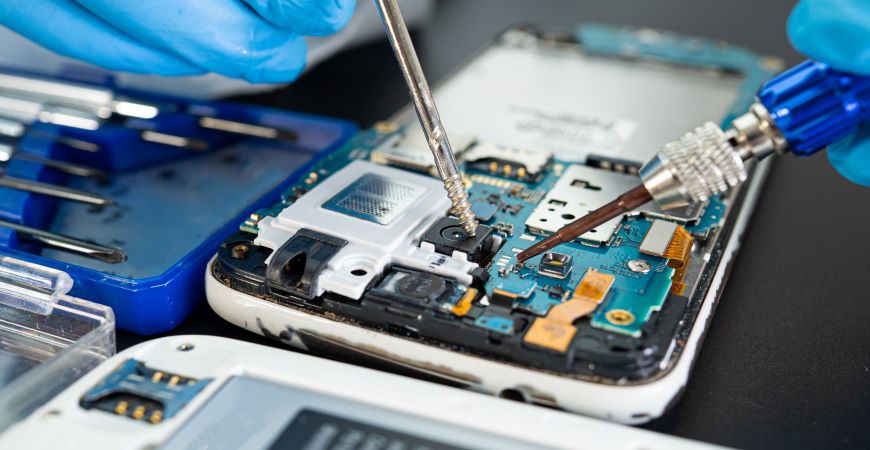Built to last and last

What is premature obsolescence? Products are said to be prematurely obsolescent when they have an unexpectedly short lifespan. A washing machine part that breaks, a smartphone that slows down, a TV which isn’t compatible with the latest software, or a games console that feels outdated – all of these prematurely obsolescent products become useless, unwanted and difficult to recycle. Premature obsolescence drives overconsumption and waste. E-waste in particular is growing – a staggering 54 million metric of it is thrown away each year[1]. This could double by 2050[2] without rapid and serious action.
Can I fix it? If products break down too soon because of premature obsolescence, consumers face two choices: repair it or throw it away. But new international and European policy developments are aiming to change this. ‘Right to repair’ rules being proposed in the US will make consumer products easier to fix, with parts that can be easily removed and replaced or fixed. On the supply side, right to repair will also open up the market for repair services, by limiting the use of expensive, approved dealers and open up services to qualified, independent suppliers. A first set of EU rules on a ‘right to repair’ came into force in March 2021 under its Ecodesign Directive. Manufacturers and importers now have to make essential parts for electronic devices available to professional repairers for 10 years after the last unit of a model has come to market. This helps deliver parts of their circular economy action plan[3] by ushering in a new era of complementary services like repair or support, to shift businesses away from solely relying on selling new products.
What do consumers want? What can SMEs deliver for consumers? SMEs and consumers can work together to be part of the solution to premature obsolescence. Consumers are keen to get products repaired but find it hard and expensive. Euroconsumers organisations in Portugal, Spain, Belgium and Italy[4] run a web reporting tool where consumers can report product failures. This tool has also been used in Germany and the Netherlands and provides a rich source of data. From around 14,000 direct consumer reports we can see that smartphones, washing machines, TVs, dishwashers, printers and ‘smart’ connected vacuum cleaners made up the biggest categories for earlier than expected failure.
Further consumer market research from Euroconsumers gives some vital insights into what kind of repair services people want. No matter where you are in the supply chain, SMEs can grasp the opportunity be part of this vital new repair market and create products that last:
- As a manufacturer think about how to make products durable, repairable, reusable and easy to disassemble. This will not only help with repairing and replacing parts but also help them be recycled correctly, or reused in the production cycle. For electronic devices, avoid common bugbears like locking down or gluing in main components which make replacing batteries or repairing other parts impossible. Euroconsumers is part of an EU Horizon multi-stakeholder consortium on measure and testing for product repairability, called PROMPT. Find out more about how to design, deliver and document epairable and long lasting products here.
- If you are a retailer: whether you are on or offline or a blend of both, the needs of consumers for support in looking after products for the long term are the same. SMEs can set up repair services and become trusted centres for advice on how to keep e-devices up-to-date with additional storage or security updates and perform regular optimisation. For non-digital devices, consumers need support on regular maintenance, refurbishment or advice on replacement parts or just cleaning and patching up cosmetic damage to keep products looking good. Selling protective equipment like phone cases or outdoor equipment covers also all contribute to expanding the lifespan of products. Read new consumer research showing access and cost are most important factors in repairs. Find out some of the reasons why consumers replace products too soon.
- If you are a community business: work with local social enterprises, repair schemes and local authority take back schemes and lead the way in delivering the Right to Repair. SMEs could also support consumers to be more than just owners of goods, and instead be participants in a new markets for repair, rental, exchange and sharing services which can help revive local economies. Find out how the Right to Repair can boost new markets (in Italian).
[1] http://ewastemonitor.info/wp-content/uploads/2020/12/GEM_2020_def_dec_2020-1.pdf [2] https://www.unep.org/ietc/resources/publication/future-e-waste-scenarios [3] https://ec.europa.eu/environment/pdf/circular-economy/new_circular_economy_action_plan.pdf [4] Italy: https://www.altroconsumo.it/obsolescenza-programmata Belgium: https://www.test-achats.be/trop-vite-use Spain: https://www.ocu.org/barometro-de-obsolescencia-prematura Portugal: https://www.deco.proteste.pt/contra-obsolescencia-prematura

